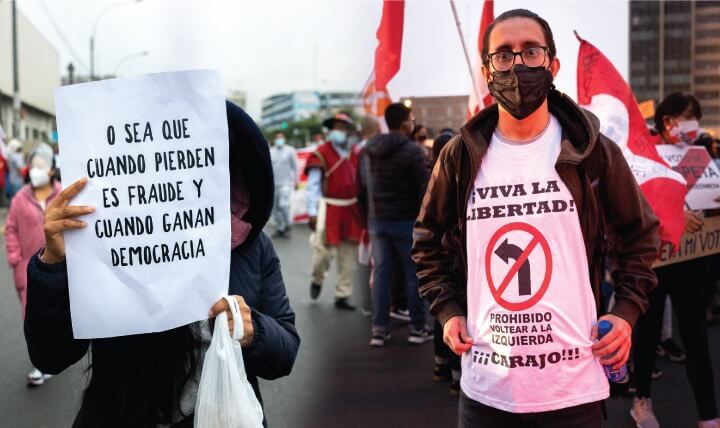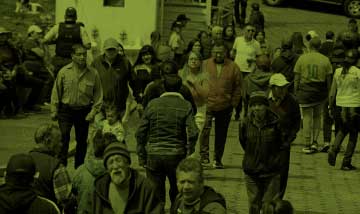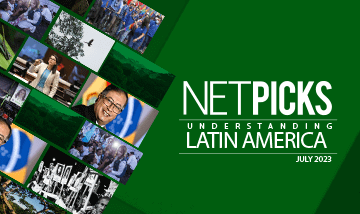This is an updated version of the article that was originally published in elDiarioAR
Not many people remember that in the 1980’s, Peru was one of Latin America’s most interesting countries from a leftist point of view. At that time, the group was called the United Left, a strong political-electoral bloc that was made up of a number of different political movements and parties and won several mayorships, including the cities of Lima, Arequipa, Cusco, and Puno, becoming the second-most-powerful national political force in the 1985 elections.
We all know what happened then. The emergence of the Shining Path, an armed messianic group identified with Maoism, and the start of a civil war that ended up going on for almost two decades, made a negative reconfiguration of Peru in political terms. Human rights violations, the death of a large number of peasants (seventy thousand victims, three-fourths of them Quechua and Aymara, according to Rodrigo Montoya), and the institutional left’s debacle that resulted from the process. Despite Shining Path being completely defeated, the crimes against humanity that were perpetrated, above all, by the military during Alberto Fujimori’s dictatorship (1990-2000), expanded the threshold of political violence while opening up a new political and economic phase for the country that was accompanied by untamed neoliberalism.
However, with terrorism’s breathing down the neck increasingly a distant memory and guaranteed impunity for the military, the elites were able to create a certain fear within the Peruvian collective worldview that is recurrently triggered during electoral campaigns by associating the ideas of terrorism, communism, and the left as a single threat. Ever since then, and in a context of weakened political parties, the various experiences of the institutional left in Peru have had to take on a dual challenge: on the one hand, getting rid of the fear-mongering campaigns that have been ferociously orchestrated by the dominant media; while on the other, creating a transformation agenda to overcome neoliberalism while appealing to subordinate sectors existing both in society and transregionally, in a country that has historically lived a division between the highlands and the coast, passing through the Amazon.
One of the attempts that generated a high level of political expectation was the election of Ollanta Humala, who was president from 2011 to 2016. Within the framework of the Latin American progressive wave, Humala presented his candidacy as being the architect of “The Great Transformation,” with a nationalist and social inclusion program. However, in the second round of elections against Keiko Fujimori, the promised “great transformation” was reduced to a less disruptive “Roadmap.” Shortly after taking office, Humala took a militaristic turn that showed the continuity of the “Order and Investments” demanded by the mining sectors. Not long thereafter, he expelled the leftist representatives from his administration to partner up with the establishment. Repression of social and environmental protests tightened even further. In the administration’s first year alone, 17 people died during the protests, especially in those against mining projects. Two of these, Conga (in Cajamarca) and Tía María (in Isaly, near Arequipa), ended up becoming emblematic conflicts in terms of the extractivist cycle being experienced in Latin America. As the sociologist Ramón Pajuelo would say, Humala became a symbol of “progressivism that never materialized,” marking the continuity of a neoliberal extractivist model, with a marked repressive bias.
In 2016, the emergence of a young leader in Verónika Mendoza stirred the political soup and generated new expectations. Mendoza is an anthropologist and began as a congresswoman during the time Humala was a key political force (she was co-founder of his political party). Because in 2016 she came in third place in the first round presidential elections, she did not make it into the runoff. Originally from Cusco, Mendoza speaks Quechua fluently (her father is a Peruvian Quechua speaker and her mother is French), and sparked a discourse on social change that also focused on gender equality and, to a lesser extent, criticized extractivism. A rapid rupture of the Broad Front (Frente Amplio), which was led by former priest and sociologist Marco Arana, who has historically fought mining extractivism and led the Land and Freedom Movement, quickly dissolved the possibility of building a broader, more plural left that would fight both neoliberalism and extractivism. Despite the fact that Mendoza created her own political party, New Peru (Nuevo Peru), and gained national and international visibility, she ended up losing a large swath of her electorate in the first round of the 2021 elections, finishing in fifth place.
Against all odds, with 19% of the vote, Pedro Castillo, a teacher and union leader of rural and humble origin, a peasant well known for his role in the 2017 teacher strikes, won first place in the first round of April this year. Castillo, originally from Cajamarca Province, was invited to join the Free Peru (Peru Libre) Party, which has a Marxist-Leninist and Mariateguist leaning. The most visible leader and founder of Free Peru is Vladimir Cerrón, who was Junin Regional Governor from 2011 to 2014 and returned to that post in 2019, despite being removed from office seven months later after being convicted of the crime of inappropriate business dealings. Before the first round elections, Cerrón released a video detailing his difference with the NGO-influenced left that he claimed was represented by Mendoza and Arana. In fact, Cerrón appeared to be trying to articulate a regional, provincial radicalism.
It we want to analyze what type of left Castillo represents, we would undoubtedly say that it is a traditional left based on social organizations and workers’ unions that, until now, has mostly reflected a regional scope. His program entitled “A Corruption-Free Peru in the Bicentennial” appeals to political order (transparency), health (healthcare as a right and a plan to fight the Covid-19 pandemic). The central core of his message is anti-neoliberal in nature: relaunching employment and the popular economy, beginning a second agrarian reform, gas for everyone, a new tax on windfall profits, etc. In the political sphere, Castillo has proposed a Constituent Assembly to draft a new Constitution. At the same time, his discourse includes no demands for gender equality, environmentalism, or plurinationality associated with indigenous peoples, all of which are narratives specific to the 21st century intersectional lefts. Most people will remember that Castillo is a union leader, someone who is used to lobbying and negotiation, making him more pragmatic than ideological. One thing that is for sure is that new alliances were formed between the first and second round elections. Castillo not only made efforts to distance himself from the party’s founder, Vladimir Cerrón, but also sought out new support, on the one hand, from New Peru, the party led by Mendoza.
The possibility of a Castillo victory generated panic among the elites. Like never before, they reactivated fear-mongering campaigns to reach antediluvian levels. Nearly the entire media apparatus aligned against the “communist” Castillo and refused to broadcast campaign events while giving full coverage to his rival, Keiko Fujimori. Despite the fact that she has no democratic credentials and is facing court actions for corruption and money laundering, Keiko turned into the ipso facto preferred candidate of hegemonic sectors, all in the name of “democracy.” She was even supported by her historic arch enemy, the author Mario Vargas Llosa. As the researcher Raphael Hoetmer points out, from an international viewpoint, what happened in that Peru campaign can only be compared with the 1988 plebiscite promoted by the dictator Augusto Pinochet, which, as we know now, ended up backfiring on him.
The results of the runoff election held on June 6 handed Pedro Castillo a narrow victory, though uncertainty about the results may well continue for several weeks, above all because the Popular Force candidate, Keiko Fujimori, refuses to accept her defeat (it is the third consecutive defeat for Fujimori in presidential elections), along with a challenge filed against 200,000 votes mostly from rural areas. The vote reflects Peru’s social and regional division, since while Lima (which is home to nearly 30% of the country’s population) and part of the Amazon Region voted for Fujimori, the Andes and the Southern Region overwhelmingly supported Castillo.
On June 15, once 100% of votes had been processed and added up, the National Organization for Electoral Processes (ONPE) confirmed that the results still showed a 44,240 vote advantage for Pedro Castillo, who obtained 50.125%, with Keiko Fujimori reaching 49.875%. Peru has long been a fragmented country with weak political parties. As a result, this is not the first time something similar has happened, since in the last elections (2016), Fujimori lost against neoliberal PPK (Pedro Pablo Kuczynski) by 42,597 votes, which means a 0.248% margin.
However, the political panorama of 2021 is quite different. Attempts made to ignore the reality of Castillo’s win, painting him as a Cerrón puppet, and the endemic racism of certain sectors of Lima society have caused political tension to grow exponentially. From the challenges filed against vote tallying sites by Popular Force (Fuerza Popular), which hired major Lima law firms to do so, to an exacerbation of panic that ended up causing a mass wave of savings withdrawals and the currency to lose value, and the authoritarian attempts by certain sectors (a letter by former military personnel calling to ignore the Castillo win, among other demands), and the National Electoral Board’s delay in proclaiming a winning ticket, all served to generate a high level of uncertainty. Some analysts have even warned the international community of the danger that we are witnessing a “slow coup.”[1]
At the same time, the judiciary was analyzing the possibility of applying pre-trial detention to Keiko Fujimori at the request of the attorney general, who had requested up to 30 days of prison against her due to money laundering in relation to contributions received from the Brazilian firm Odebrecht, as well as from numerous business persons who financed her 2006 and 2011 presidential campaigns.[2]
On June 19, Ipsos, a consulting firm, performed a quick count of what they call “vote tabulation outliers,” finding that, “after comparing the results of vote tabulations and the voting sites, 95.28% are within normal values. The outliers are similar for both candidates. If the outliers were eliminated for both parties, the percent variation would not be significant and the election results would remain the same.”[3]
Beyond the weak nature of Peru’s political parties, it is important to remember that in the streets, Peru is a country with many demonstrations on a number of issues that include mining extractivism (there are many movements and social organizations and there is a high level of environmental conflict), along with anti-repressive marches that are often held in opposition to corruption. This was seen in the December 2020 demonstrations, which had the participation of many young people and gave rise to what has been called the “Bicentennial Generation.” There are many pending items for the newly elected National Congress to process. These include ratification of the Escazu Agreement (a regional treaty that guarantees access to information and protection of environmental defenders), something that was blocked by Fujimori’s supporters and the mining sector. Conflict has persisted during the pandemic, with pressure from mining sectors that demanded more flexible protocols. This flexibilization resulted in 3000 infections in said industry in July 2020.[4] Finally, we must bear in mind that in mid-June, Peru had recorded 190,000 deaths, making it the country with the highest mortality rate from Covid-19 in relation to its population.
Support for Castillo has been palpable in the streets, with large demonstrations organized by collectives, civil society associations, and human rights defenders, as well as by leftist political parties. However, it is difficult to forecast exactly what Castillo’s administration will end up being in a country that is so politically unstable, with high levels of inequality and turbulence, racism, and narrow-mindedness among its elites, added to an institutional left with a short-term, fragmented vision. What we do know is that Castillo has generated an excessive reaction by both elites and the media, to the extent that today, many are concerned about the political and economic reaction of hegemonic sectors because of such a close win by a candidate who runs contrary to their interests. Something to be said on Castillo’s behalf is that he was able to expand the sphere of political representation and broaden alliances, obtaining the votes of many sectors that try to imagine a different, more dignified Peru, one that is democratic and egalitarian, beyond the obvious shortcomings of the new president’s future and the limited cross-sectional votes he obtained.
[1] https://www.nytimes.com/2021/06/23/peru-election-castillo-fujimori.html
[2] https://www.france24.com/es/am%C3%A9rica-latina/20210621-peru-poder-judicial-revisara-prision-preventiva-keiko-fujimori
[3] https://www.ipsos.com/es-pe/analisis-de-outliers-en-los-resultados-de-las-elecciones-presidenciales-2021-segunda-vuelta
[4] https://www.lavanguardia.com/internacional/20200716/482330589415/la-conflictividad-minera-persiste-en-peru-en-plena-pandemia-de-la-covid-19.html





